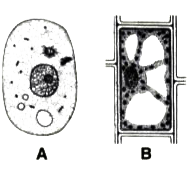Between amphibins and birds, which will be able to cope with globl warming ? Given reason .
Step-by-Step Solution:
1. Understanding the Organisms:
- Identify the two groups being compared: amphibians and birds.
- Recognize that birds are classified as urethermals, meaning they can tolerate a wide range of temperatures.
2. Temperature Tolerance:
- Explain that urethermals (birds) can survive in varying temperatures, which is crucial during periods of global warming when temperatures are expected to rise significantly.
- In contrast, amphibians are classified as stenothermal, meaning they can only survive within a limited temperature range.
3. Impact of Global Warming:
- Discuss the implications of global warming, which leads to increased temperatures and environmental changes.
- Highlight that birds, due to their urethermal nature, are better suited to adapt to these changes compared to amphibians.
4. Conclusion:
- Conclude that birds will be more capable of coping with global warming than amphibians because of their ability to withstand a broader range of temperatures.
Final Answer: Between amphibians and birds, birds will be able to cope with global warming more effectively due to their urethermal nature, which allows them to tolerate a wide range of temperatures, unlike amphibians, which are stenothermal and can only survive in a limited temperature range.
---
- Identify the two groups being compared: amphibians and birds.
- Recognize that birds are classified as urethermals, meaning they can tolerate a wide range of temperatures.
- Explain that urethermals (birds) can survive in varying temperatures, which is crucial during periods of global warming when temperatures are expected to rise significantly.
- In contrast, amphibians are classified as stenothermal, meaning they can only survive within a limited temperature range.
- Discuss the implications of global warming, which leads to increased temperatures and environmental changes.
- Highlight that birds, due to their urethermal nature, are better suited to adapt to these changes compared to amphibians.
- Conclude that birds will be more capable of coping with global warming than amphibians because of their ability to withstand a broader range of temperatures.
Topper's Solved these Questions
- BOOK - XII BOARD PREVIOUS YEAR PAPER ENGLISHCHAPTER - XII BOARDSEXERCISE - SET - I SECTION C14videos
XII BOARDS
- BOOK - XII BOARD PREVIOUS YEAR PAPER ENGLISHCHAPTER - XII BOARDSEXERCISE - SET - I SECTION D8videos
XII BOARDS
- BOOK - XII BOARD PREVIOUS YEAR PAPER ENGLISHCHAPTER - XII BOARDSEXERCISE - [OUTSIDE DELHI : SET-III] SECTION - C10videos
XII BOARDS
- BOOK - XII BOARD PREVIOUS YEAR PAPER ENGLISHCHAPTER - SAMPLE PAPER 2019EXERCISE - Section E Part B3videos
SAMPLE PAPER 2019
Similar Questions
Knowledge Check
- Question 1 - Select One
Given below are some differences between primary air pollutants and secondary air pollutants.
Which one of the following is an incorrect difference ?A Primary air pollutantsSecondary sir pollutantsThese persist in the form in which they are added to the environment.These are formed by interaction among the primary pollutants.B Primary air pollutantsSecondary sir pollutantsThese are more toxic than the secondary pollutants.These are less toxic than the primary pollutantsC Primary air pollutantsSecondary sir pollutantsExamples include DDT,CO2Examples include Ozone, PANDNone of these
Which pair of lines in Fig. are parallel? Given reasons.
View SolutionBetween an annual and a perennial plant , which one has a shorter juvenile phase ? Give one reason.
View SolutionYou are given the following three leness. Which two lensee will you use as an eyepiece and as an objective to construct an astronomial telescope ? Give reason.
 View Solution
View SolutionCarefully examine structures A and B of pentose sugar given below. Which one of the two is more reactive ? Give reason
 View Solution
View SolutionGiven below are the sketches of two types of cells A and B

Which one of these is a plant cell? Give reason in support of your answer.View SolutionThe given figure of a human shows a pedigree analysis. Answer the following questions based on the figure.

Which one is heterozygous, male or female? Give reason.View SolutionThe map distance in a certain organism between genes A and B is 8 units, between B and C is 4 units and between C and D is 12 units. Which one of these gene pairs will show more recombination frequency? Give reason in just one single sentence in support of your answer.
View Solution

